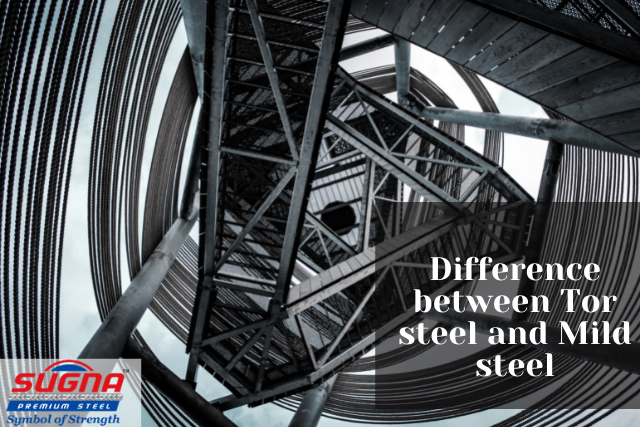Difference between Tor steel and Mild steel
Steel is by far the most widely used construction material in the world. As a building material, it is uniquely designed to provide strength and durability under extreme temperatures for all purposes.
The benefits of steel in construction have resulted from its ability to be shaped into virtually any form necessary; this versatility allows for long-term use at an affordable cost.
Useful features of steel
- Durability is obtained using high-strength steels, which provide stiffness and resistance to bending and flexion in large building structures. This stiffness provides a free-space design feature, being highly resistant to buckling that causes failure. What’s more, is that steel can be used for foundations for buildings and roads and bridges and highways—all without any concrete needed.
- The environmentally-friendly nature of steel makes it perfect for older city areas where materials like wood are not readily available. Using steel, these companies will not have to worry about trees being cut down.
- Steel is unmatched in its strength and durability, which offer incredible weight load capacity. It also has excellent fire resistance, which means it’s perfect for high-rise buildings; they may never need sprinklers or fire alarms thanks to this ingenious material.
- Steel is truly a marvel of engineering with properties we vastly underestimate today. Because of its properties, steel has become ubiquitous in construction. It has been the go-to material since its introduction to the world centuries ago. While some materials are preferable in specific applications, steel is a top choice in many ways.
- Steel is an affordable building material. It is more cost-effective than other materials like concrete and wood. This means it’s not just easy on the environment but also on your wallet!
- The material also has a longer lifespan which means you don’t have to spend money and time on repairs as often as you would with wood or concrete buildings. The only maintenance you need to do is periodic repainting or rust prevention.
In this article, we are going to talk about the difference between Tor Steel and Mild Steel
What is TOR Steel?
Tor steel full form is Toristeg Steel Corporation of Luxembourg. TOR is a type of steel that undergoes cold twisting and deformation after the heat treatment process.
What is mild steel?
Mild steel, on the other hand, is a type of steel with very low carbon content.
Utility difference between TOR and Mild steel
The utility difference between tor steel and mild steel are as follows:
Uses of TOR steel
- Tor bars can be bent easily
- Tor steels are easy to manage while welding
- Cost reduces up to 30℅ to 40%
- The bars can be identified easily due to their shape
- The bars have excellent bonding properties
Uses Of Mild Steel
- Best for Gate and fencing as it is hard to break
- The malleability of this steel makes it ideal for building Machinery parts
- Excellent flexibility of mild steel makes it perfect for pipeline construction
Chemical property difference between Tor and Mild Steel
Mild steel and tor steel have different chemical properties. Let’s understand the differences:
Tor steel properties and chemical constitution
- Carbon
- Sulphur
- Phosphorus
Listed below is the constitution for Mild steel
- Carbon
- Silicon
- Manganese
- Phosphorus
- Sulphur
- Aluminum
- Copper
- Chromium
- Nickel
- Iron
Physical difference between Tor and mild steel

Mild steel contains between 0.05 and 0.25 percent carbon as cementite, making it soft. It has somewhat low stiffness, but it is easy to assemble and hardened by carburizing the surface. A high iron content means that it is more likely to be corrosive.
Cold-twisted deformed steel bars are referred to as Tor steel. When steel bars are twisted after extension, their surfaces deform. If you need high yield strength and good concrete adhesion, this is the way to go.
Mild steel is malleable, ductile, and flexible. Apart from this, it is easy to shape. Carburising expands the surface hardness.
Tensile stress in RCC (reinforced cement concrete) slab beams and other structures are met using mild steel bars.
Though plain in appearance, these round steel bars have diameters ranging from 6 to 50 millimeters. Since they come in long lengths, these poles are easy to work with and can be cut and bent without causing damage. The use of mild steel bars for reinforcing concrete with solid bars is clearly stated.
The tor steels also serve as a slip prevention mechanism. Tor steel is another name for these bars, which are cold twisted deformed (CTD). The CTD bars are the most commonly used bars for RCC work.
Conclusion
Tor steel means a type of steel that has been cold twisted and deformed after heat treatment. Low alloy, low carbon steels are referred to as mild steel. The structural TOR steel specifications are ASTM 36, sometimes known as A36, a widely accepted industry standard.
For mild steel, 1018 is an AST specification. Chemically, A36 and 1018 bars have a lot in common, although their specs are very different.
If you need quality TMT steel then hire experts like Sugna TMT Steel for all your construction requirements.

